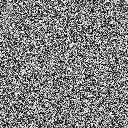
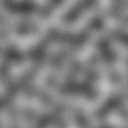
Non-coherent noise (left) and Perlin noise (right)
|
Disclaimer, January 2017:
This document is glaringly outdated (note last
update above) and is presented primarily for
historical interest, because other archived copies
have begun to disappear/bit rot. While I'm not aware of
are any glaring inaccuracies, it's certainly not
the document I would write now if I wanted to
present a modern tutorial on procedural noise for
graphics. Turns out that 20-year-old me was missing a few key concepts, for instance the relationship between the "ease curve" discussed below and the cubic hermite spline that underlies the GLSL smoothstep function. Many of the links below are broken, follow at your own risk. If you're interested in a more modern take on these topics, a great place to start would be Inigo Quilez's articles and shadertoy examples. |
I wrote a demo program in C++ that includes a Perlin noise texture class, which I hope provides a decent example of C++ code for Perlin noise. You can find the demo at http://www.robo-murito.net/code.html.


When I talk about a noise function, I mean a function that takes a coordinate in some space and maps it to a real number between -1 and 1. Note that you can make noise functions for any arbitrary dimension. The noise functions above are 2-dimensional, but you can graph a 1-dimensional noise function just like you would graph any old function of one variable, or consider noise functions returning a real number for every point in a 3D space.
These images were all created using nothing but Perlin noise:
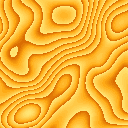
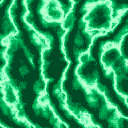

Let's look at the 2D case, where we have the function
noise2d(x, y) = z,with x, y, and z all real (floating-point) numbers. We'll define the noise function on a regular grid, where grid points are defined for each whole number, and any number with a fractional part (i.e. 3.14) lies between grid points. Consider finding the value of noise2d(x, y), with x and y both not whole numbers -- that is, the point (x, y) lies somewhere in the middle of a square in our grid. The first thing we do is look at the gridpoints surrounding (x, y). In the 2D plane, we have 4 of them, which we will call (x0, y0), (x0, y1), (x1, y0), and (x1, y1).
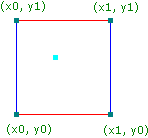
Now we need a function
g(xgrid, ygrid) = (gx, gy)which takes each grid point and assigns it a pseudorandom gradient of length 1 in R2 ('gradient' is just the name for an ordered pair or vector that we think of as pointing in a particular direction). By pseudorandom, we mean that g has the appearance of randomness, but with the important consideration that it always returns the same gradient for the same grid point, every time it's calculated. It's also important that every direction has an equal chance of being picked.
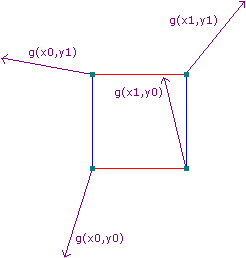
Also, for each grid point, we generate a vector going from the grid point to (x, y), which is easily calculated by subtracting the grid point from (x, y).
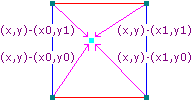
Now we have enough to start calculating the value of the noise function at (x, y). What we'll do is calculate the influence of each pseudorandom gradient on the final output, and generate our output as a weighted average of those influences.
First of all, the influence of each gradient can be calculated by performing a dot product of the gradient and the vector going from its associated grid point to (x, y). A refresher on the dot product -- remember, it's just the sum of the products of all the components of two vectors, as in
(a, b) · (c, d) = ac + bd .Since I'm really tired of writing subscripts, we'll just refer to these 4 values as s, t, u, and v, where
s = g(x0, y0) · ((x, y) - (x0, y0)) ,So here's a 3D-ish picture of some influences s, t, u, and v coming out of the R2 plane (note that these probably wouldn't be the actual values generated by the dot products of the vectors pictured above).
t = g(x1, y0) · ((x, y) - (x1, y0)) ,
u = g(x0, y1) · ((x, y) - (x0, y1)) ,
v = g(x1, y1) · ((x, y) - (x1, y1)) .

Geometrically, the dot product is proportional to the cosine of the angle between two vectors, though its unclear to me if that geometrical interpretation helps one visualize what's going on. The important thing to know at this point is that we have four numbers, s, t, u, and v which are uniquely determined by (x, y) and the pseudorandom gradient function g. Now we need a way to combine them to get noise2d(x, y), and as I suggested before, some sort of average will do the trick.
I'm going to state the obvious here and say that if we want to take an average of four numbers, what we can actually do is this:
We're not taking a plain vanilla-flavored average here, but instead, a weighted average. That is, the value of the noise function should be influenced more by s than t when x is closer to x0 than x1 (as is the case in the pictures above). In fact, it ends up being nice to arrange things so that x and y values behave as if they are slightly closer to one grid point or the other than they actually are because that has a smoothing effect on the final output. I know that sounds really silly, but noise without this property looks really stupid. In fact, it sounds so silly that I'm going to write it again: we're going to want the input point to behave as if its closer to one grid point or another than it actually is.
This is where we introduce the concept of the ease curve. The function 3p² - 2p³ generates a nice S-shaped curve that has a few characteristics that are good for our purposes.
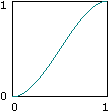
What the ease curve does is to exaggerate the proximity its input to zero or one. For inputs that are sort of close to zero, it outputs a number really close to zero. For inputs close to one, it outputs a number really close to one. And when the input is exactly one half, it outputs exactly one half. Also, it's symmetrical in the sense that it exaggerates to the same degree on both sides of p = ½. So if we can treat one grid point as the zero value, and the other as the one value, the ease curve has the exact smoothing effect that just we said we wanted.
Ok, I've droned on long enough, it's calculation time: first, we take the value of the ease curve at x - x0 to get a weight Sx. Then we can find the weighted average of s and t by constructing a linear function that maps 0 to s and 1 to t, and evaluating it at our x dimension weight Sx. We'll call this average a. We'll do the same for u and v, and call the result b.
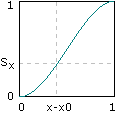
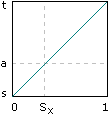
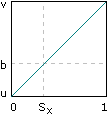
The above figures should satisfy you that no matter where x happens to fall in the grid, the final averages will always be between s and t, and u and v, respectively. Mathematically, this is all simple to calculate:
Sx = 3(x - x0)² - 2(x - x0)³Now we find our y dimension weight, Sy, by evaluating the ease curve at y - y0, and finally we take a weighted sum of a and b to get our final output value z.
a = s + Sx(t - s)
b = u + Sx(v - u)
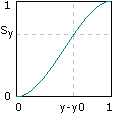
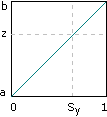
And there you have it. So all you have to do is call the noise function for every pixel you want to color, and you're done. Probably.
An interesting consequence of all of this is that the noise function becomes zero when x and y are both whole numbers. This is because the vector (x, y) - (x0, y0) will be the zero vector. Then the dot product of that vector and g(x0, y0)will evaluate to zero, and the weights for the averages will also always be zero, so that the zero dot product will influence the final answer 100%. The funny thing is that looking at the noise function, you would never guess that it ends up being zero at regular intervals.
The neat thing about noise is that it's locally variable, but globally flat -- so if we zoom out to a large degree, it will just look like a uniform value (zero in fact). So, we don't care if the noise function starts to repeat after large intervals, because once you're zoomed out far enough to see the repeat, it all looks totally flat anyways.
So now we should feel justified in doing a little trick with modulus. Say we're doing noise in 3D, and we want to find the gradient for some grid point (i, j, k). Let's precompute a permutation table P, that maps every integer from 0 to 255 to another integer in the same range (possibly even the same number). Also, let's precompute a table of 256 pseudorandom gradients and put it in G, so that G[n] is some 3-element gradient.
Now,
g(i, j, k) = G[ ( i + P[ (j + P[k]) mod 256 ] ) mod 256 ]But on a computer, modulus with 256 is the same thing as a bitwise and with 255, which is a very fast operation to perform. Now we've reduced the problem of a possibly involved function call into nothing but some table lookups and bitwise operations. Granted, the gradients repeat every 256 units in each dimenstion, but as demonstrated, it doesn't matter.
This speedup is also mentioned on Perlin's web page, and is actually used in his original implementation.
Floop(x, y, z) = ( (t - z) * F(x, y, z) + (z) * F(x, y, z - t) ) / (t)Now each function call takes twice as long to calculate, but since you're probably not going to use this cycling technique in real time, it probably doesn't matter.
The explanation
Consider the graph of a noise function F(x, y, z) for some fixed x and y. The problem is, you want F(0) = F(t) and there is no guarantee that will be the case with any old x, y, and t. Actually, since any given x and y should have no influence on the repeating aspect of the animation, we can for all practical purposes throw them out while we're developing our repeating function, and consider the simplified case of a one-dimensional noise function F(z).
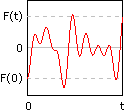
We need to take this function and change it into one where it is guaranteed that F(0) = F(t). Here's an expanded view of our noise function showing its behavior from -t to t:
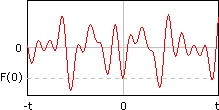
Now we define a new function F'(z) that behaves like F(z) when z is near zero, but behaves like F(z - t) when z is near t. If you think about it, you see that F'(0) = F(0), and that F'(t) = F(t - t) = F(0). We can do this with a simple linear interpolation by considering a linear function which is equal to F(z) at 0, and equal to F(z - t) at t.
High school algebra tells us that this linear function has a slope of
(rise) / (run) = (F(z - t) - F(z)) / (t - 0) = (F(z - t) - F(z)) / tand an intercept of F(z). Now we set up F' as this linear interpolation operating on z:
F'(z) = slope(z) + interceptWhich is basically the same as the function given above. If you look at F' next to F, you can see that the function does indeed repeat in that F'(0) = F'(t). Also notice that the peaks just to the right of F'(0) are the same as the peaks just to the right of F'(0), and that the peaks just to the left of F'(t) are virtually identical to the peaks just to the left of F(0).
= ( (F(z - t) - F(z)) / t )(z) + F(z)
= ( ( (z) * F(z - t) - (z) * F(z) ) / t ) + F(z)
= ( ( (z) * F(z - t) - (z) * F(z) ) / t ) + (t / t) * F(z)
= ( (z) * F(z - t) - (z) * F(z) + (t) * F(z)) / (t)
= ( (z) * F(z - t) + (t-z) * F(z) ) / (t)
= ( (t-z) * F(z) + (z) * F(z - t) ) / (t)

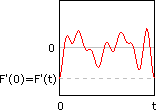
If you had a little calculus and too much free time, you could prove that this looping (and the tiling in the next section) is truly seamless: not only does F(0) = F'(t), but all their derivatives should match up as well. Which means that no one should be able to tell where the repeat actually happens.
Ftileable(x, y) = (A pattern should be emerging here, so it shouldn't surprise you that you'll need evaluate a weighted sum of 8 calls to the noise function if you want to have a repeating animation that tiles in the x and y dimenstions. I'm not going to write it out here out of space considerations, and also because it should be evident what the sum will be.
F(x, y) * (w - x) * (h - y) +
F(x - w, y) * (x) * (h - y) +
F(x - w, y - h) * (x) * (y) +
F(x, y - h) * (w - x) * (y)
) / (wh)